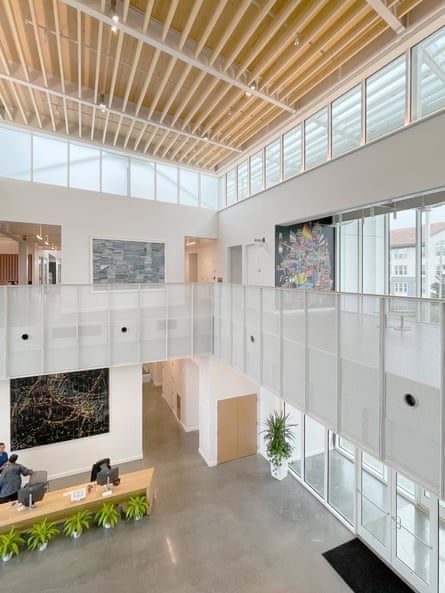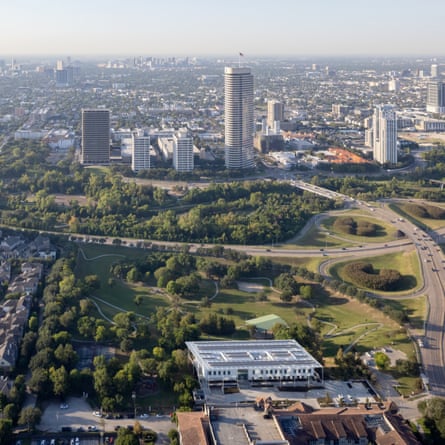Few figures have shaped the form and fortunes of a city as much as Jesse H Jones moulded Houston’s. From the early 1900s, the lumberyard owner turned real estate developer, turned banker and Democrat politician, built more than 35 skyscrapers across the Texan “bayou city”. Known as “Mr Houston”, Jones was instrumental in securing funds to build the shipping channel that connected the city to the sea, creating an inland port linked to 17 railway lines, transforming its prospects.
As Fortune magazine put it in 1940: “He built Houston up from a one-night stand on Buffalo Bayou into the second-largest and fastest growing metropolis in the south.” It is now the fourth biggest city in the US, its port the second busiest in the country. Jones’s legacy still towers above the streets: if all of his buildings were placed on top of each other – from the elegant Rice Hotel to the art deco Gulf Tower – they would extend two miles into the sky.
Now, 66 years since his death, Jones’s great fortune has spawned a more subtle architectural addition to Houston’s jumbled, un-zoned cityscape. Perched on the brow of a hill overlooking the rolling greenery of Spotts Park, where the bayou wiggles its way to the west of the city, the new Houston Endowment HQ stands as an elegant, low-rise temple to philanthropy. A colonnade of toothpick-slender steel columns rises 12 metres to support a gossamer-thin aluminium canopy that oversails a cluster of white cubic forms, sheltering a staggered series of outdoor terraces from the harsh Texan sunshine. The volumes slide in and out, cantilevered above planted beds, their scalloped surfaces adding depth to the play of shadows cast by the perforated louvres overhead.
“It’s essentially a giant back porch,” says Kevin Daly, referring to that classic southern domestic social space. The 65-year-old Los Angeles-based architect, who designed the building in collaboration with Mexican office Productora, studied at Houston’s Rice University and knows the city well. “We wanted to create the feeling of a relaxed, open relationship to the public, and a place where discussions can spill outdoors.”
Jesse Jones and his wife, Mary Gibbs Jones, founded the Houston Endowment in 1937, with a focus on education, healthcare and the arts. They funded the first building for women to live on campus at Rice, as well as hospitals for the Texas Medical Center, and a performing arts centre for the city, completed after Jones’s death. Since then, the fund has grown to $2.57bn and now sees around $100m of grants awarded each year to local non-profit organisations, with a focus on public education, civic engagement, arts, parks and social services.

The Endowment operates almost on the scale of a local council, with dedicated departments for each of its core programmes, from improving parks and playgrounds, to increasing voter participation among immigrant communities, to supporting independent, non-partisan local journalism. But, based in dark wood-panelled offices way up on the 64th floor of the corporate JPMorgan Chase Tower in downtown, the organisation had always lacked a visible public face.
“It had a spectral presence in the city,” says Daly. “Everyone knew what it was, but no one knew what it looked like.” And those who did visit often felt overwhelmed by the stuffy, rarefied atmosphere, more redolent of an old-school Texan oil company HQ than a progressive funder of charitable community groups.
“It felt like you were in a museum,” says Ann Stern, president and CEO of the Houston Endowment since 2012. “It was a sombre, serious space that made you feel like you had to lower your voice. We already have such a power imbalance with the groups that we work with, and the offices made people feel that if they were not old and established, it was no place for them.”
By contrast, their new $20m home feels like entering the light-flooded, airy surrounds of a modern art gallery, channelling strains of the city’s 1980s Menil Collection by Renzo Piano. In an unusual move for a US office building, the project was procured through an open international competition, organised by London-based Malcolm Reading Consultants, and the rigour of the process is evident in the result. The tight budget has been carefully deployed to create an environment that works hard with minimal means – a testament to Daly’s track record with affordable housing and public schools, and Productora’s experience with fabricators in Mexico, where much of the metalwork was made.
Big glass doors lead into an 11-metre high atrium, where a broad staircase rises up to open-plan offices and a staff canteen, with an events space off to one side. Bold contemporary works from a diverse array of Houston artists line the walls, while the exposed undersides of cross-laminated timber floor slabs hang overhead, supported by a framework of slim, bolted steel sections. It looks as if the whole thing has been assembled from a lean kit of parts – and could be dismantled and re-used just as easily. At every possible moment, doors spill out on to terraces that overlook the park, making the building feel like a pavilion in a garden.
In summer, the city swelters in 37C heat, with over 90% humidity, making low-energy cooling a challenge. Rather than aim for an ultra high-tech environmental system, which the organisations felt that the Endowment funds would never be able to match, the architects opted for simple, legible measures that could be copied.
“The idea was to make it as welcoming as the shadow under a tree,” says Wonne Ickx of Productora. “The best part of Houston is not its architecture, but the incredible canopy of live oaks that covers the city. We’re trying to extend that sense of a sheltering canopy.”
“Someone should be able to walk in and see how it works,” says Daly. There’s the canopy for shading, which is covered with solar panels for energy, while simple ceiling fans – manually operable by the occupants – also reduce the amount of air-conditioning needed in summer. In a more techie touch, a series of geothermal wells have been drilled 90 metres below ground, which reduces the demand on cooling in summer and heating in winter. It’s basic stuff, but it means that the building operates at net zero carbon for at least three-quarters of the year.

“It’s not talked about much, but one of the most important environmental aspects is about right-sizing the building,” adds Ickx, explaining how the original size of the project was cut down during the design process, going from three floors to two. “We made it as efficient as possible, cutting out excessive facilities, like extra meeting rooms and a gym, which they just didn’t need, being right on the edge of the park.”
Given the environmental credentials of the building, and the climate-conscious campaigns that the Houston Endowment funds, there appears to be a contradiction in where some of the charitable billions are invested. Will the organisation be divesting its dollars from the climate-wrecking fossil fuel industry – following the likes of the Rockefeller, MacArthur and Ford Foundations?
“No,” says Stern. “We’re in Texas, and a number of people on our board are from the oil and gas industry. We want to do as well with our investments as we possibly can, so we can put more money back into the community. It may come at some point, but it’s going to be an investment decision that causes us to divest.”
In a conservative state where renewable energy is still a dirty word among the dominant oil-loyal Republicans, the Endowment is at least trying to send a message in its own architecture. Some may question the use of aluminium for the cladding and canopy, which comes with a high embodied energy cost, although Daly’s team assures it has a high recycled content, and a similar carbon footprint to other cladding choices. Perhaps the bigger question, in this post-pandemic world of working from home, is if they actually need such a building?
“With hybrid working, I thought I would only come into the office for the minimum amount of time,” says Carlos Villagrana, a programme officer in the education team. “To get to the old office, you had to drive into downtown, park in the garage, and take three escalators and two elevators to get there. But now I find myself looking forward to coming into work every day. I really enjoy the sense of light and space, and it feels like the teams and our organisations all know each other much better now.”
The history of Jesse Jones may be confined to a small room behind the reception desk, but his pioneering spirit lives on in this lightweight, low-energy building. Connected to the pedestrian and bike paths of the bayou park, it stands as a progressive beacon that the rest of this sprawling, oil-rich, car-dominated city would do well to learn from.

